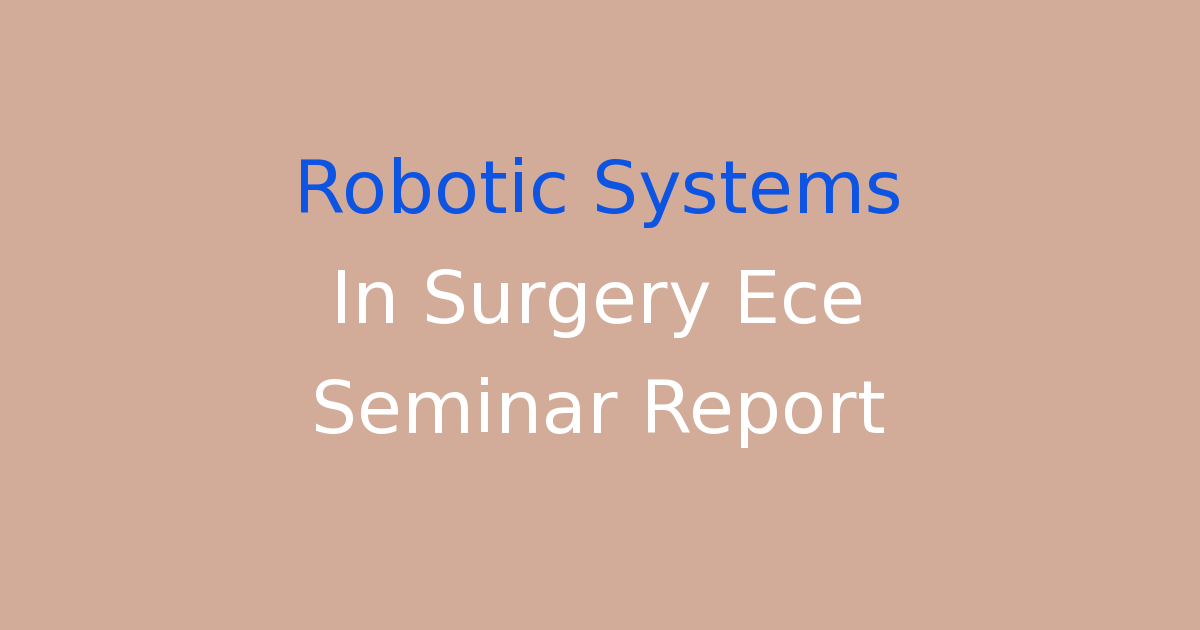Seminar report on robotic systems in surgery in the field of electronic and communication engineering.
Robotic Systems in Surgery: ECE Seminar Report
Introduction
Robotic systems have revolutionized the field of surgery, allowing for greater precision and control during procedures. These systems are often used in minimally invasive surgeries, allowing for smaller incisions and faster recovery times for patients. In this seminar report, we will explore the current state of robotic systems in surgery and propose a new system that aims to address some of the limitations of the existing technology.
Problem Statement
While robotic systems have many benefits, they are not without their drawbacks. Current systems can be expensive to purchase and maintain, limiting their accessibility to smaller healthcare facilities. Additionally, some systems have limitations in terms of dexterity and range of motion, which can impact the success of certain procedures. There is a need for a more affordable and versatile robotic system that can be used in a wide range of surgical procedures.
Existing System
The current state of robotic systems in surgery involves the use of systems such as the Da Vinci Surgical System, which is a popular choice for many hospitals. This system consists of a robotic arm with multiple joints, controlled by a surgeon from a console. The system provides high-definition 3D visuals and precise instrument control, allowing for complex surgeries to be performed with greater accuracy.
Disadvantages
Despite its benefits, the Da Vinci Surgical System and other similar systems have limitations. These systems can be prohibitively expensive, with costs running into millions of dollars for the purchase and installation of the system. Maintenance and training costs can also add to the overall expense, making it difficult for smaller hospitals to invest in this technology.
Proposed System
Our proposed system aims to address some of the limitations of the existing technology by creating a more affordable and versatile robotic system. This system will have a modular design, allowing for different components to be easily swapped in and out depending on the surgical procedure being performed. The system will also incorporate advanced artificial intelligence algorithms to assist surgeons during procedures, enhancing their capabilities and improving patient outcomes.
Advantages
The proposed system will have several advantages over existing technology. By being more affordable, the system will be accessible to a wider range of healthcare facilities, allowing more patients to benefit from robotic surgery. The modular design will also allow for greater flexibility in terms of the procedures that can be performed, as surgeons can easily switch out components as needed. The incorporation of artificial intelligence will improve the precision and accuracy of surgeries, leading to better outcomes for patients.
Features
Some of the key features of the proposed system include:
- Modular design for easy customization
- Advanced artificial intelligence algorithms for enhanced surgical capabilities
- High-definition 3D visuals for better visualization during procedures
- Precision instrument control for greater accuracy
- Intuitive user interface for ease of use
Conclusion
In conclusion, robotic systems have greatly improved the field of surgery, allowing for more precise and efficient procedures. However, there is still room for improvement in terms of affordability and versatility. Our proposed system aims to address these limitations by creating a more accessible and flexible robotic system that incorporates advanced artificial intelligence technology. With these advancements, we believe that robotic surgery will continue to revolutionize healthcare and provide better outcomes for patients in the future.

